The world is home to thousands of snake species, each with a different color, shape, and size. This includes many different species of black and white snakes.
Sometimes, snakes are solely black and white, giving an interesting monochromatic appearance. However, other snakes may pair that iconic black-and-white theme with other colors as well.
Below, you’ll be able to meet 12 different species of black and white snakes. Many of them are solely sporting these two colors, but some species may also have other colorations or morphs. Ready to learn more? Let’s dive in!
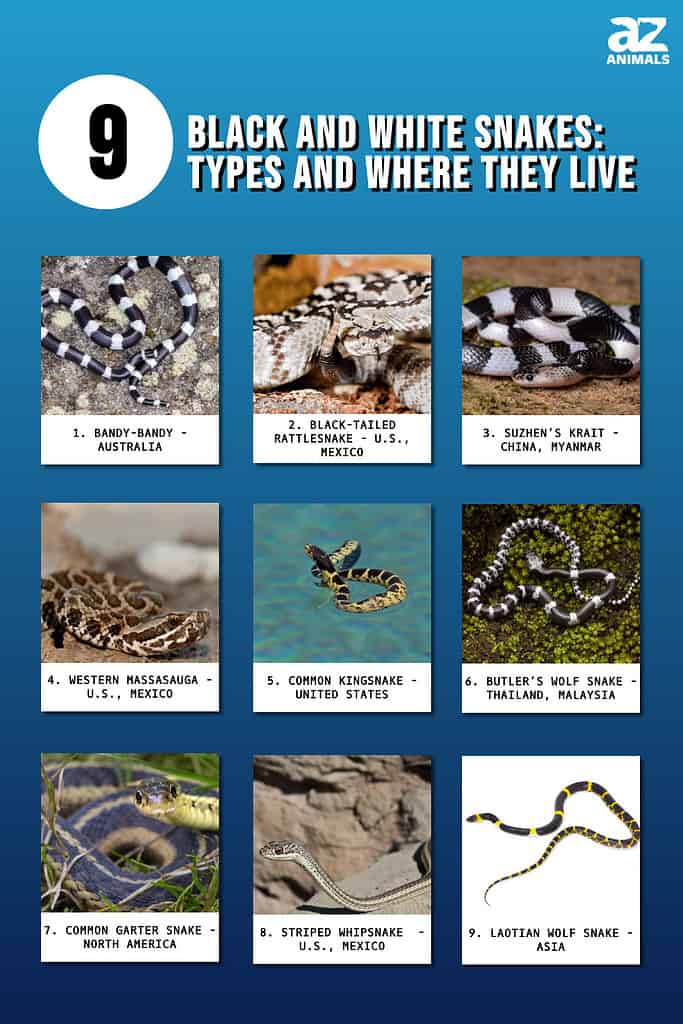
1. Bandy-Bandy
The first black and white snake on this list is the bandy-bandy, also known as the “hoop snake.” Both of these common names refer to the black and white bands or hoops that wrap around the length of the snake’s body. There are six different species of bandy-bandy snakes. However, you will only find these species in Australia. In addition, they boast a unique black-and-white banded morph.
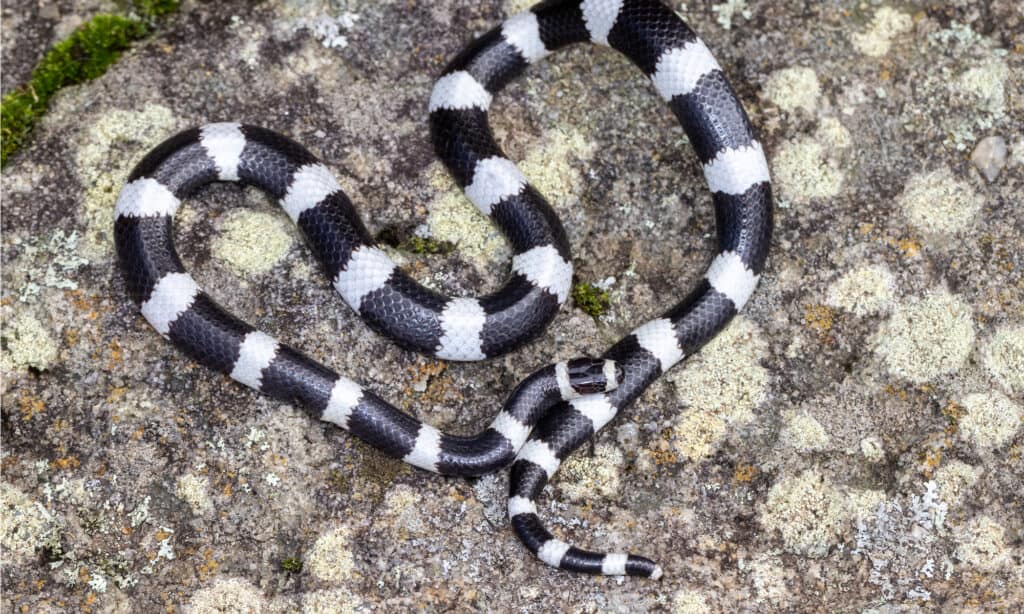
Bandy-bandy snake is native to Australia and has six different species.
©Ken Griffiths/Shutterstock.com
Species of Bandy-Bandy
The eastern bandy-bandy (Vermicella annulata) is the most common species of this black and white snake. Its species name comes from the Latin word annul-, which means ring. They live most often in the northern and eastern regions of Australia. Here, they can thrive in a variety of habitats. This ranges from coastal forests to desert sandhills.
The wide-banded northern bandy-bandy (Vermicella intermedia) is less common. No matter how large they grow to be, they’ll only sport less than 75 black and white rings. They thrive in eucalyptus forests. It is closely related to the northern bandy-bandy (Vermicella multifasciata). These black and white snakes live in the same areas in Australia. You can distinguish them by their number of bands, with the northern bandy-bandy showcasing over 75 bands.
Fourth is the Pilbara bandy-bandy (Vermicella snelli). This species of bandy-bandy snake is native only to the Pilbara region of Australia. Therefore, it thrives in the many diverse habitats offered by the Western Australian ecosystem. Like the Pilbara bandy-bandy, the worm-like bandy-bandy (Vermicella vermiformis) lives only in specific locations within Australia: one in the central and one in the southern regions.
Lastly, the Weipa bandy-bandy (Vermicella parscauda) is the newest black and white snake species in the bandy-bandy genus to be discovered. It was found in 2018. However, it lives only in the Weipa region of Australia.
2. Black-Tailed Rattlesnake
The black-tailed rattlesnake (Crotalus molossus) is a venomous snake species that lives in Mexico and the United States, specifically in the southwestern United States, Texas and Arizona, and Central Mexico. There are four species, each one boasting some variation of color that places them as one of many black and white snakes.
These snakes grow to be medium-sized as adults, with lengths up to 42 inches. Some individuals may appear to sport other colors than black and white, such as browns and olive green. Additionally, they are known to have a sort of mask formed by a black marking on their face.
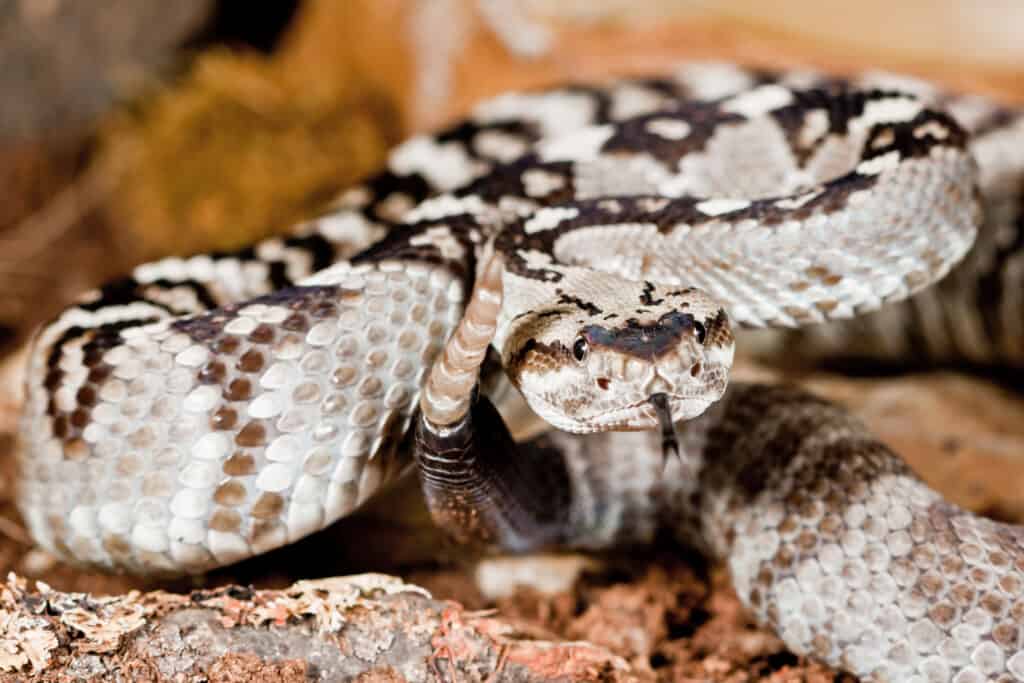
The black-tailed
rattlesnake
is a venomous snake found in Central Mexico, Texas, and Arizona.
©iStock.com/pitchwayz
3. Suzhen’s Krait
Suzhen’s krait (Bungarus suzhenae) is a newly identified species. This new member of the list of black and white snakes was first documented in 2021. It receives its name from Bai Su Zhen, the Chinese snake goddess from the “Legend of the White Snake.” It is found in southwestern China and northern Myanmar.
Although this species of krait wasn’t formally identified until 2021, it has a long history. In 2001, herpetologist Joseph B. Slowinski was bitten by what was thought to be a black-and-white banded krait. He later passed from these wounds, leading to various studies into the snake species that bit him. The results from these studies showed an entirely different species than the black-and-white banded krait: Suzhen’s krait.
Kraits are known for being a dangerous species, and many can be identified through their black-and-white coloration. Suzhen’s krait sports a white belly and large, black splotches on its back, or dorsal, side. These black markings tend to overlap or otherwise touch, making a solid black dorsal side appear.
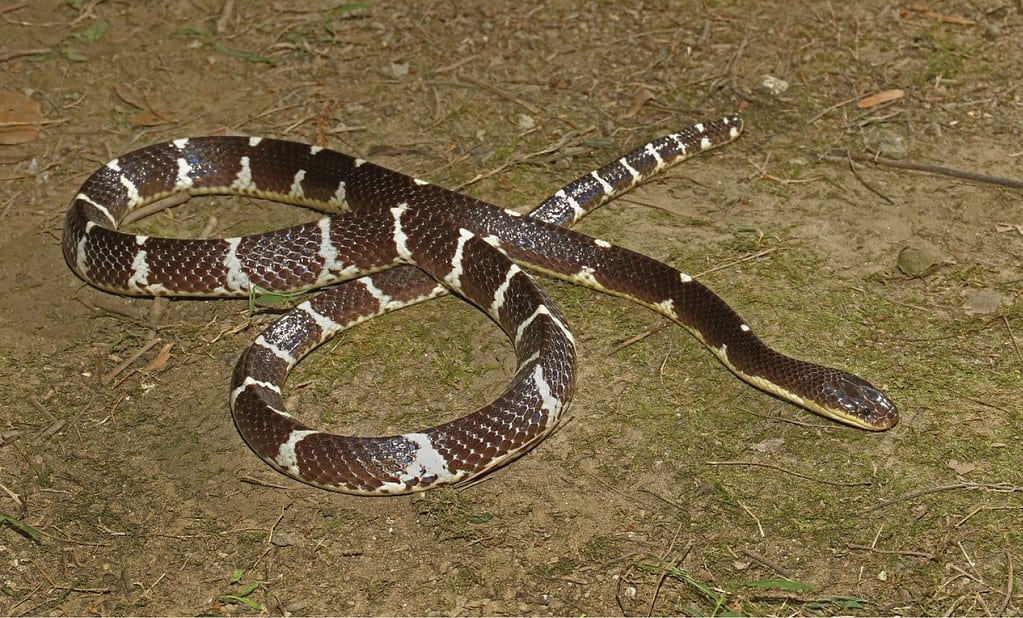
It receives its name from Bai Su Zhen, the Chinese snake goddess from the “Legend of the White Snake.”
©Chen Z-N, Shi S-C, Vogel G, Ding L, Shi J-S (2021) / CC BY 4.0, Wikimedia Commons – License
4. Western Massasauga
The western massasauga (Sistrurus tergeminus) is another one of many venomous black and white snakes. Like the black-tailed rattlesnake, it is found in the United States and Mexico. However, it is not a type of rattlesnake, although both are considered pit vipers.
Western massasaugas can grow to be between 14 and 36 inches long as adults. There are two different species based on where they are located. S. t. tergeminus, or the plains massasauga, is found in the Great Plains. S. t. edwardsii, or the desert massasauga, is found in the desert regions of the southwestern states of the United States and northern Mexico. In some individuals, their black spots may appear to be dark brown or grey instead.

Western massasaugas are black and white snakes that inhabit areas in the United States and Mexico.
©Nick Kanakis/Shutterstock.com
5. Common Kingsnake
The common kingsnake (Lampropeltis getula) goes by many names. Some of these common names include the Eastern kingsnake, Carolina kingsnake, and chain kingsnake. It is known for its black-and-white appearance, as well as its personality. Both of these traits have made this a favorite among snake enthusiasts and pet owners alike.
There are nine different subspecies of common kingsnakes currently identified. These species are scattered throughout the southeastern United States. Their diet is made up of other snakes, specifically venomous snakes like copperheads and coral snakes. It is immune to venom, although it has adapted methods of avoiding bites from venomous snakes while hunting.

The kingsnake has become a favorite of the black and white snakes with snake enthusiasts.
©Matt Jeppson/Shutterstock.com
6. Butler’s Wolf Snake
The Butler’s wolf snake (Lycodon butleri) is a species of snake native to Thailand and Malaysia. This species is named after Arthur Lennox Butler, a Karachi-born British zoologist. It is found in a habitat known as the montane forest, which can easily reach elevations of almost one mile above sea level. Montane forests are known for their rich, unique biodiversity, with ecosystems capable of supporting species others worldwide cannot.
The black and white banding, plus its location, can make it difficult to tell Butler’s wolf snake apart from species of krait. This is an important distinction to make, as kraits are highly venomous species of snake.

The Butler’s wolf snake lives in a habitat known as the montane forest.
©iStock.com/Vince Adam
7. Common Garter Snake
If you’ve ever seen a common garter snake (Thamnophis sirtalis), there’s a chance you’re wondering how it ended up on a list of black and white snakes. This is because they can come in a variety of different morphs or colors. While there is a black-and-white morph of the garter snake, some morphs don’t feature either of these colors!
Garter snakes are thin snakes, although they can grow to be up to around 4 feet long. They produce mild venom. It can be effective when it comes to hunting their prey, such as small amphibians, but it doesn’t pose a medical emergency to humans.
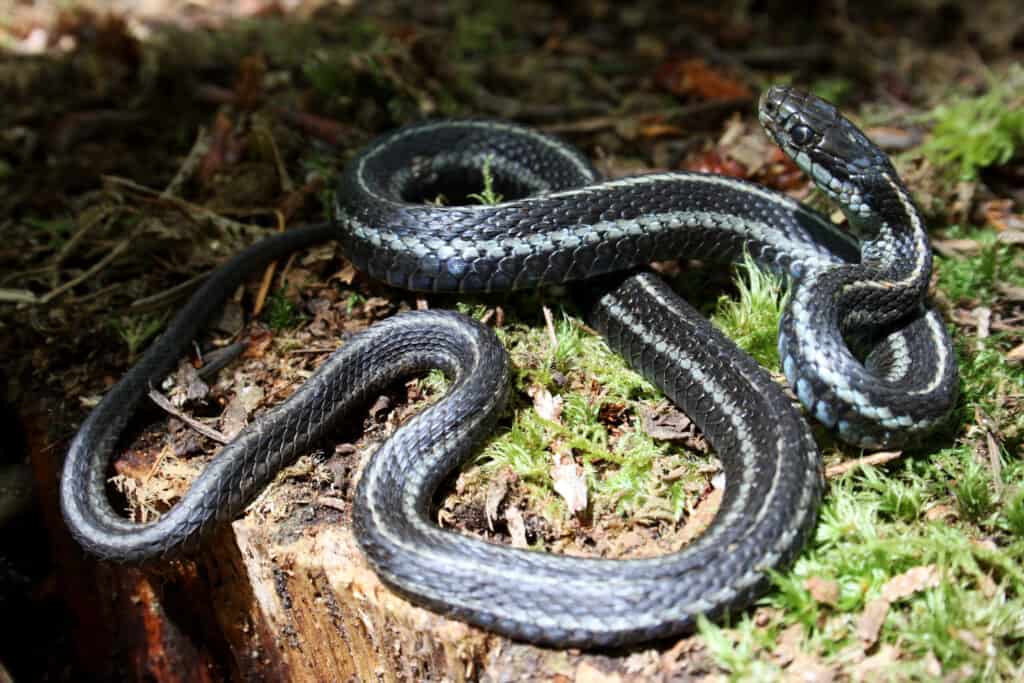
A garter snake can come in various colors, including black and white.
©Colby Hess/Shutterstock.com
8. Striped Whipsnake
The striped whipsnake (Masticophis taeniatus) is a nonvenomous species known for its black dorsal side and its white, vertical stripe. However, it can also come in other colors, such as brown or olive green. It is native to the western region of the United States and the northernmost region of Mexico. It can be found as far south as Michoacán, however.
There are two different subspecies of striped whipsnake: Masticophis taeniatus girardi and Masticophis taeniatus taeniatus. M. t. Taeniatus is known as the desert whipsnake due to its environment. M. t. girardi is named for Charles Frédéric Girard, a French herpetologist.
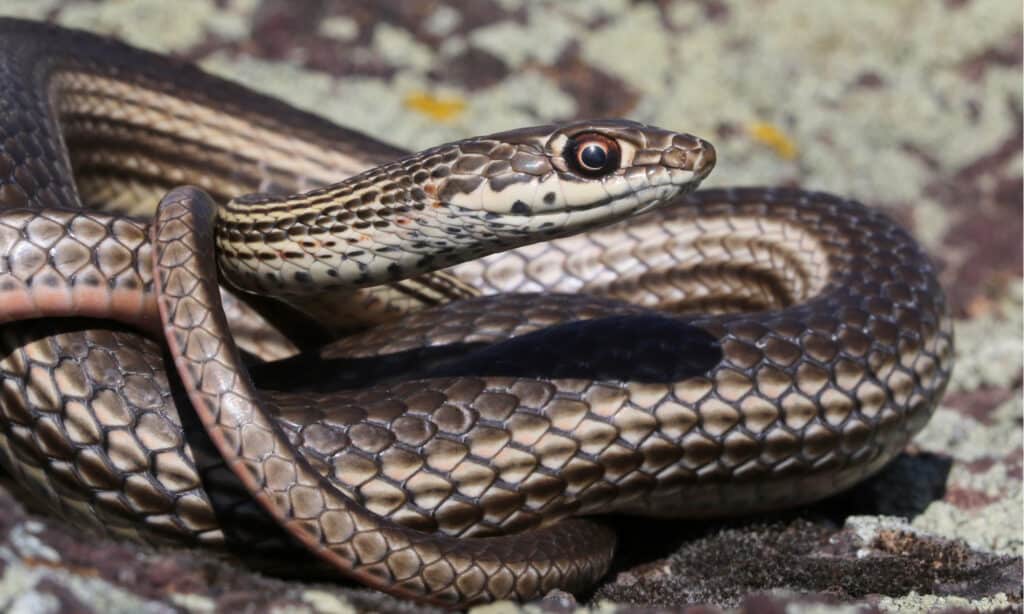
This black and white snake is known as the striped whipsnake and can be found in the United States and Mexico.
©Randy Bjorklund/Shutterstock.com
9. Laotian Wolf Snake
The Laotian wolf snake (Lycodon laoensis) is one example of a black-and-white snake that also features other colors. This snake is black and yellow along its dorsal side or its back. However, it is white along its ventral side, which is its stomach. The Laotian wolf snake is native to Asia and is found in countries such as Laos (for which it is named), India, Thailand, China, and others.
Because of their appearance and location, wolf snake species are often mistaken for banded kraits. Both of these are black and white snakes, but kraits are a highly venomous snake species.
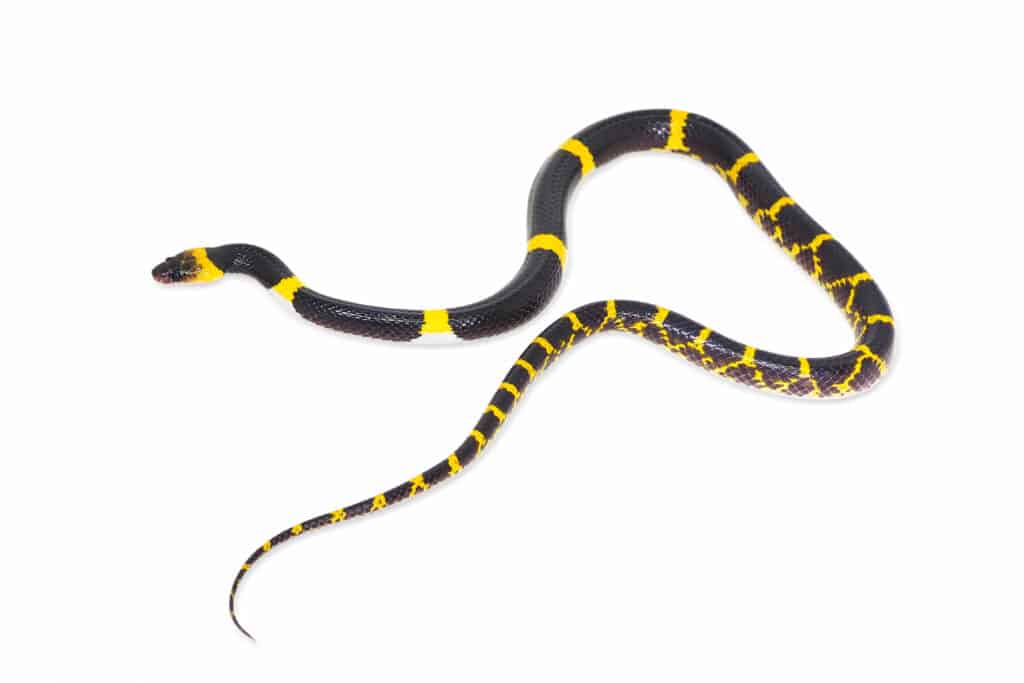
Laotian wolf snake is typically black and yellow; however, it is also white on the stomach side of the snake.
©Binturong-tonoscarpe/Shutterstock.com
Summary of 9 Black and White Snakes: Types and Where They Live
| # | Snake | Location |
|---|---|---|
| 1 | Bandy-Bandy | Australia |
| 2 | Black-Tailed Rattlesnake | Mexico, United States |
| 3 | Suzhen’s Krait | China, Myanmar |
| 4 | Western Massasauga | United States, Mexico |
| 5 | Common Kingsnake | United States |
| 6 | Butler’s Wolf Snake | Thailand, Malaysia |
| 7 | Common Garter Snake | North America |
| 8 | Striped Whipsnake | United States, Mexico |
| 9 | Laotian Wolf Snake | Laos, Thailand, China, India |
The photo featured at the top of this post is © Matt Jeppson/Shutterstock.com
Discover the "Monster" Snake 5X Bigger than an Anaconda
Every day A-Z Animals sends out some of the most incredible facts in the world from our free newsletter. Want to discover the 10 most beautiful snakes in the world, a "snake island" where you're never more than 3 feet from danger, or a "monster" snake 5X larger than an anaconda? Then sign up right now and you'll start receiving our daily newsletter absolutely free.
Thank you for reading! Have some feedback for us? Contact the AZ Animals editorial team.






